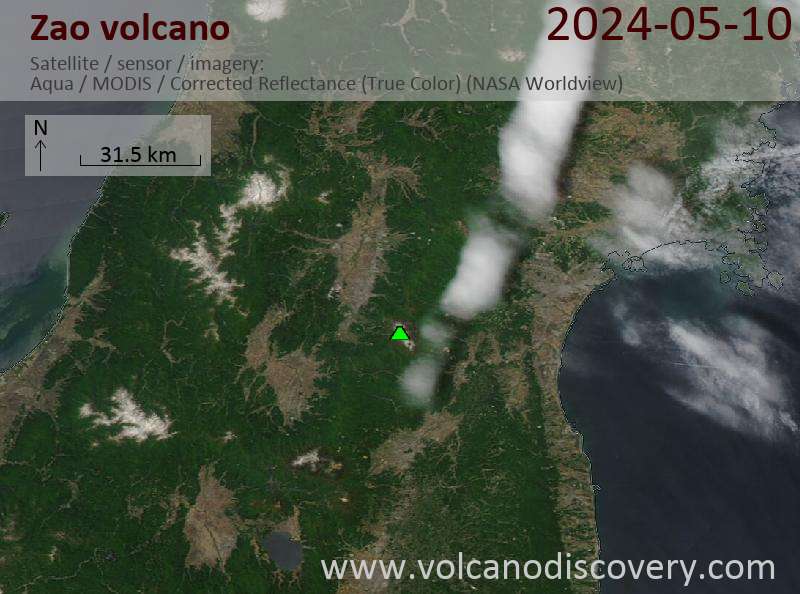Zao Volcano
Zao (or Zaozan, Zaosan) volcano is the most active volcano of northern Honshu and consists of a group of stratovolcanoes forming the crest of the divide between the Pacific Ocean and the Japan Sea.
The older parts of the complex are Ryuzan volcano in the west and Byobu and Fubo volcanoes forming the southern group. Zao volcano proper (Chuo-Zao) is the youngest edifice and forms the central part of the group. One of its youngest summit lava domes is Goshiki-dake, which contains the active Okama crater, the source of most of the frequent historical eruptions recorded since the 8th century AD.
Okama crater contains a colorful, strongly acidic crater lake (pH 1.3).
Zao volcano eruptions: 1940, 1939 (?), 1927 (?), 1905, 1897 (?), 1896, 1895, 1895, 1894, 1890 (?), 1873, 1867, 1833, 1831, 1830, 1822, 1821, 1809, 1806, 1804, 1796, 1794, 1694, 1670, 1669, 1668, 1641, 1630, 1623-24, 1622, 1620, 1400 ± 100 years (radiocarbon), 1350 (?), 1331-33 (?), 1230, 1227, 1183, 884, 773 (?), 300 AD ± 200 (RC), 1600 BC (?, RC), 2000 BC ± 500 (tephrochronology), 2300 BC ± 75 (RC), 2600 BC ± 200 (RC), 3350 BC ± 50 (RC), 3850 BC ± 200 (RC), 4150 BC ± 200 (RC), 5500 BC (?, RC), 5600 BC (?, RC), 7600 BC (?, RC)
Latest nearby earthquakes
| Date and Time | Mag / Depth | Distance / Location | |||
|---|---|---|---|---|---|
| Aug 14, 07:10 am (GMT +9) | 1.0 104 km | 8.5 km (5.3 mi) to the SE | Info | ||
| Thursday, August 7, 2025 GMT (1 quake) | |||||
| Aug 7, 09:31 am (GMT +9) | 0.7 3.7 km | 10 km (6.2 mi) to the W | Info | ||
| Wednesday, August 6, 2025 GMT (1 quake) | |||||
| Aug 7, 02:34 am (GMT +9) | 0.3 7.9 km | 21 km (13 mi) to the S | Info | ||
Background
The Pleistocene Ryuzan volcano forms the western Zao group (Nishi-Zao), and Byobu and Fubo volcanoes form the southern Zao group (Minami-Zao). The complex was constructed over granitic basement rocks as high as 1500 m and thus has a relatively small volume. The 7 cu km Zao volcano proper forms the central ao group (Chuo-Zao), a volcanic complex topped by several lava domes and the Goshiki-dake tuff cone, aligned along a NW-SE trend. Several episodes of edifice collapse produced debris avalanches during the Pleistocene.Zao Volcano Photos




Significant volcanic eruptions: Zao volcano
Additionally, there are 9 uncertain or discredited eruptions from Zao volcano.
| Date | Note | VEI | Deaths | Damage | ||
|---|---|---|---|---|---|---|
| Okama Historical obs./docs. | 1 | |||||
?? | Uncertain Eruption | 1? | ||||
?? | Uncertain Eruption | 1? | ||||
Discredited Eruption | ||||||
| Okama Historical obs./docs. | 1? | |||||
?? | Uncertain Eruption | 1? | ||||
?? | Uncertain Eruption | 1? | ||||
| Okama Historical obs./docs. | 1 | |||||
| Okama Historical obs./docs. | 2 | |||||
| Okama Historical obs./docs. | 1 | |||||
| Okama Historical obs./docs. | 2? | |||||
?? | Uncertain Eruption | 1? | ||||
| Okama Historical obs./docs. | 1? | |||||
| Okama Historical obs./docs. | 2 | |||||
| 1867 Oct 21 (eruption | Historical obs./docs. | 2 | 3 | Info | ||
| Okama Historical obs./docs. | 2 | |||||
| Okama Historical obs./docs. | 2 | |||||
| Okama Historical obs./docs. | 2 | |||||
Historical obs./docs. | ? | |||||
| Okama Historical obs./docs. | 2 | |||||
| Okama Historical obs./docs. | 2 | |||||
| Okama Historical obs./docs. | 2 | |||||
| Okama Historical obs./docs. | 2 | |||||
Eruptions of Zao volcano
A M 4.7 earthquake occurred at 17h58 local time on 1 September a few kilometers ESE of the summit. There were no visible changes.
In July 1990, many small earthquakes were detected below the summit of Zao volcano.
(GVP)
On 21 Oct 1867, a phreatic eruption caused an overflow of muddy water from Okama crater lake, which killed 3 bathers who were in the hot springs at the foot of Goshiki-dake. ...more info
Zao Volcano FAQ
+When was the last eruption of Zao volcano?
The last confirmed eruption of Zao occurred in 1940.
+How often does Zao volcano erupt?
Since 884 AD, Zao volcano has had at least 31 historically documented eruptions. This means that it erupts on average every 36.8 years.
+How active is Zao volcano at present?
Zao volcano is occasionally active: Since 1900, it has had 2 eruptions, and been active during 2 years out of 126 as of now. This means, Zao has been in eruption one in 63 years on average. The last eruption was in 1940 and ended 85 years ago.
+When was the largest eruption of Zao volcano?
The largest eruption known from the younger geological history of Zao volcano occurred around 300 AD. It ranks as a "vulcanian" eruption with a magnitude 3 on the VEI (Volcanic Explosivity Index) scale.
Latest satellite images
Zao Volcano Maps











































